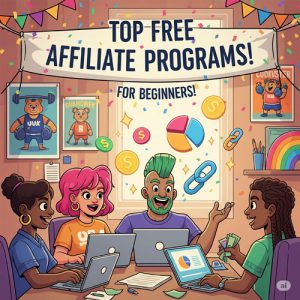 Affiliate marketing remains one of the most beginner-friendly and profitable online business models available.
Affiliate marketing remains one of the most beginner-friendly and profitable online business models available.
Whether you’re looking to make extra income or build a long-term digital asset, this comprehensive 2025 guide to affiliate marketing for beginners will walk you through every step of the process.
What Is Affiliate Marketing?
Affiliate marketing is a performance-based strategy where you earn a commission for promoting other people’s or company’s products and services. When someone clicks your unique referral link and makes a purchase, you earn a percentage of that sale.
Why Start Affiliate Marketing in 2025?
Low barrier to entry — No need for inventory or upfront costs.
Flexible schedule — Work from anywhere and set your own hours.
Scalable income — Potential to grow from side hustle to full-time income.
Growing digital economy — More people are shopping online than ever.
Step 1: Choose the Right Niche
Success starts with selecting the right niche. A good niche is:
Evergreen (stays relevant over time)
Specific (not too broad)
Solves a problem (makes promotion easier)
Profitable (has affiliate programs with good commissions)
Popular niches for beginners include:
Personal finance
Health and wellness
Productivity and software tools
Online education
Pets and home improvement
Step 2: Find Affiliate Programs
Once you’ve chosen a niche, the next step is to join affiliate programs. These are the platforms that connect you with products you can promote.
Top affiliate networks:
Amazon Associates – great for physical products
ShareASale – offers many niche merchants
ClickBank – ideal for digital products
CJ Affiliate – popular for household brands
Impact Radius – known for software and SaaS
Also check individual brand websites — many companies run in-house affiliate programs.
Step 3: Choose a Traffic Platform
Pick a platform where you’ll publish your content and build your audience.
Best platforms for beginners:
Blog – ideal for SEO and long-form content
YouTube – great for visual product reviews and tutorials
TikTok/Instagram – for short-form, viral content
Pinterest – for evergreen, visual content that drives traffic over time
Choose one platform to start. Once you gain traction, you can expand to others.
Step 4: Create Quality Content
Content is the backbone of affiliate marketing. You’re helping your audience solve a problem and recommending solutions through affiliate links.
Types of content that work well:
Product reviews
Comparison articles (e.g., “Tool A vs. Tool B”)
How-to guides
Best-of lists (e.g., “Top 5 Tools for Budgeting in 2025”)
Case studies or personal experiences
Use the target keyword in the title, URL, meta description, headers, and naturally throughout the content. Focus on long-tail keywords like “best beginner SEO tool for bloggers.”
Step 5: Build an Email List
Email marketing helps you build relationships and increase conversions. Start by offering a freebie or “lead magnet” related to your niche (e.g., checklist, guide, or mini-course).
Use free tools like:
MailerLite or ConvertKit for beginner-friendly email services
Canva to design lead magnets
Zapier to automate email sequences
Send valuable content and soft promotions through your emails.
Step 6: Drive Targeted Traffic
Traffic is essential for affiliate sales. Use both short-term and long-term strategies:
Free traffic sources:
SEO (Search Engine Optimization)
Social media (Pinterest, TikTok, Instagram)
YouTube SEO
Facebook and Reddit communities
Quora and Medium
Paid traffic (advanced):
Google Ads
Facebook Ads
Pinterest promoted pins
Focus on organic methods first to build sustainable traffic.
Step 7: Optimize and Track Performance
Use analytics to track what’s working. Look at:
Click-through rates (CTR)
Conversion rates (sales per click)
Most viewed content
Recommended tools:
Google Analytics for tracking blog traffic
ThirstyAffiliates or Pretty Links for link management
YouTube Studio for video analytics
Regularly update your best-performing content, tweak underperformers, and experiment with new formats.
Step 8: Follow Legal Requirements
Always disclose affiliate relationships clearly to remain compliant with FTC regulations.
Sample disclaimer:
This post may contain affiliate links. If you use these links to buy something, we may earn a commission at no extra cost to you.
Also, ensure GDPR compliance if targeting visitors from the EU.
Step 9: Stay Consistent and Keep Learning
Affiliate marketing for beginners success comes from consistency. Keep learning, testing, and adapting.
Tips for long-term success:
Post content weekly or bi-weekly
Engage with your audience on social media
Study top affiliate marketers
Take online courses or join forums
Final Thoughts on Affiliate Marketing for Beginners
Affiliate marketing for beginners in 2025 is a real opportunity to build passive income online. Start with a single niche, focus on helping your audience, and choose the right tools to support your efforts.
Whether you’re creating YouTube videos, writing blog posts, or designing Pinterest pins, remember that providing genuine value is the key to success.
Start today. Sign up for one affiliate program, publish one piece of content, and build from there. Your future self will thank you.



